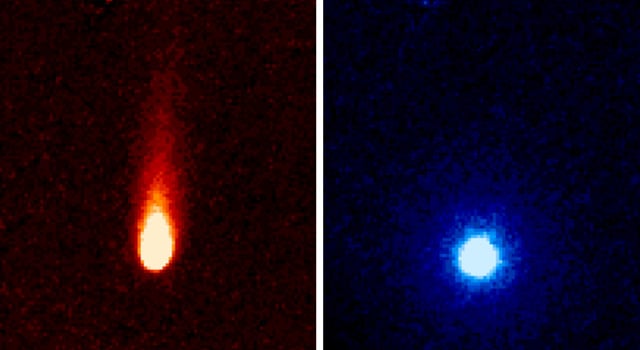As part of the
Comet ISON Observing Campaign
, the Spitzer Space Telescope was used to "stare" at the comet for 24 hours on Jun 13, 2013. Images from Spitzer's "ISON-a-thon" indicate that carbon dioxide and dust are spewing out of the comet at a fairly large rate.
"We estimate ISON is emitting about 2.2 million pounds (1 million kilograms) of what is most likely carbon dioxide gas and about 120 million pounds (54.4 million kilograms) of dust every day," said Carey Lisse, leader of NASA's Comet ISON Observation Campaign and a senior research scientist at the Johns Hopkins University Applied Physics Laboratory.
That amount of dust is about the mass of one aircraft carrier every two days or so, tweeted the
Sungrazing Comets Twitter feed,
, and the amount of carbon dioxide released per day would be enough for about 625 million cans of soda.
The images were taken by the Spitzer's Infrared Array Camera showing the comet's tail, which is about 186,400 miles (300,000 kilometers) long.
Comet ISON was about 312 million miles (502 million kilometers) from the Sun, 3.35 times farther than Earth, when the observations were made.
Comet ISON (C/2012 S1) is less than 3 miles (4.8 kilometers) in diameter (about the size of a small mountain) and weighs between 7 billion and 7 trillion pounds (3.2 billion and 3.2 trillion kilograms). However, its true size and density have not yet been accurately determined because of its distance from Earth. Like all comets, ISON is a dirty snowball made up of dust and frozen gases such as water, ammonia, methane and carbon dioxide. These are some of the fundamental building blocks, which scientists believe led to the formation of the planets 4.5 billion years ago.
"This observation gives us a good picture of part of the composition of ISON, and, by extension, of the proto-planetary disk from which the planets were formed," said Lisse. "Much of the carbon in the comet appears to be locked up in carbon dioxide ice. We will know even more in late July and August, when the comet begins to warm up near the water-ice line outside of the orbit of Mars, and we can detect the most abundant frozen gas, which is water, as it boils away from the comet."
The comet will pass within 724,000 miles (1.16 million kilometers) of the Sun on Nov. 28.
Astronomers are wondering if the comet will survive its close pass of the Sun, and also if it will live up to expectations of becoming bright enough to be seen in the daytime, as some have predicted.
Only time will tell ... and we'll be here to share the news.
Source:
JPL
 Universe Today
Universe Today
